出版物、影片工作和艺术性的节目
由约翰 John Feliks (回到英语版本 Return to English)
A Lot of Gold in the Mix: Review of Fragment from a Nonfiction Reader
4/9/2009
As a
person more interested in what inspires or fascinates
on a deep level than in what simply entertains, 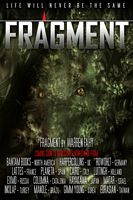 I can safely say that Warren Fahy’s debut science thriller, Fragment, offers a lot
of gold in
its undeniably dynamic mix. Make no mistake, Fragment is an
unpredictable and
wild ride for sure; I can safely say that Warren Fahy’s debut science thriller, Fragment, offers a lot
of gold in
its undeniably dynamic mix. Make no mistake, Fragment is an
unpredictable and
wild ride for sure;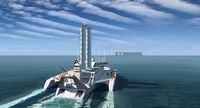 yet, somehow, out
of all of this, comes not only many delightful moments
that will stick with you long after reading the book, but also one of
the most
elusive and subtle emotions one can experience... yet, somehow, out
of all of this, comes not only many delightful moments
that will stick with you long after reading the book, but also one of
the most
elusive and subtle emotions one can experience...
CLICK HERE FOR THE FULL REVIEW.
|
WORKS IN PROGRESS
PRIOR WORK
Below are a few samples of my research papers, films, artistic programs, etc., that, for the most part,
have either been published or presented in public performance venue at least once.
ANTHROPOLOGY AND RELATED PUBLICATIONS
- Feliks, J. 2009 (in press). The graphics of Bilzingsleben: Sophistication and subtlety
 in the mind of Homo erectus. Proceedings of the XV UISPP World Congress
(Lisbon, 4-9 September 2006), British Archaeological Reports International Series, Oxford. Scientific censorship began within one week of the Congress.
Click on the link; Find out what it is that the European and U. S.
scientific communities are so afraid of that they are willing to risk
losing public trust in order to hold back empirical geometric data.
in the mind of Homo erectus. Proceedings of the XV UISPP World Congress
(Lisbon, 4-9 September 2006), British Archaeological Reports International Series, Oxford. Scientific censorship began within one week of the Congress.
Click on the link; Find out what it is that the European and U. S.
scientific communities are so afraid of that they are willing to risk
losing public trust in order to hold back empirical geometric data.
"Absolutely outstanding and stunning. You
have single-handedly demonstrated that the cognition and intellect of
these hominins may have been of an order entirely unexpected by all of us ...breathtaking." -Robert G. Bednarik
Additional note: My interest in Fragment has little to do with the popular action sequences but rather with intriguing aspects that other reviewers do not mention. For instance, apart from well-thought-out and innovative scientific ideas (such as the origins of sexual reproduction), Fragment, like some of my own work, was inspired by invertebrate fossils.
- Feliks,
J. 2008. Phi in the
Acheulian: Lower Palaeolithic intuition and the natural origins of
analogy. In Bednarik, R. G. and D. Hodgson (eds), Pleistocene palaeoart
of
the world, pp. 11-31. Proceedings of the XV UISPP World Congress
(Lisbon, 4-9 September 2006), British Archaeological Reports International Series 1804, Oxford. (See Fig. 10, Circle Studies, above right.)

“Mind-boggling
regularities which, if valid indicators, would suggest that some Lower
Palaeolithic hominins possessed concepts of spatiality significantly
different from ours, and apparently much more sophisticated.” -Robert G. Bednarik
MOTION PICTURE FILMSTOCK RESEARCH AND PUBLICATIONS
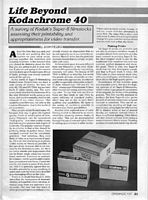
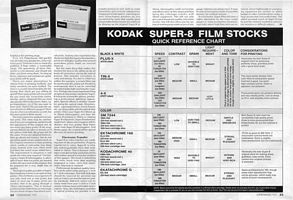
This was the final issue of Starlog Cinemagic, the sci-fi/fantasy
special effects magazine. Cinemagic inspired many amateur filmmakers who later went on to produce television programs and Hollywood films, e.g., J. J. Abrams: Star Trek (2009), Lost, Mission Impossible III. I had the privilege of sharing the pages of
this issue with a childhood inspiration, renowned special effects wizard,
Ray Harryhausen (Jason
and the Argonauts, Earth vs. the Flying Saucers, Clash of the Titans, etc.). Because I have been a long-time Harryhausen fan (in addition to Star Trek fan), I would like to
add a couple of things about Harryhausen's work for those who may
not recognize his name. Harryhausen is one of the great special effects artists in
sci-fi/fantasy having not only created some of the most
memorable sci-fi/fantasy films and animated characters but also having influenced the likes of 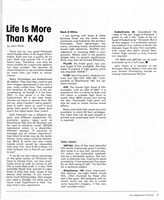 Steven
Spielberg, George Lucas, Tim Burton, Sam Raimi, James Cameron, and many others. I love these
quotes from Wikipedia regarding Harryhausen's, Jason and the Argonauts:
Steven
Spielberg, George Lucas, Tim Burton, Sam Raimi, James Cameron, and many others. I love these
quotes from Wikipedia regarding Harryhausen's, Jason and the Argonauts:
"When presenting Harryhausen with a special Academy Award, actor Tom Hanks told Harryhausen 'Lots of people say Casablanca or Citizen Kane is the greatest film of all time... no way, it's Jason and the Argonauts!'" -Wikipedia
"In April 2004, Empire magazine ranked Talos [the 100-foot tall bronze titan in Jason and the Argonauts] as the second best movie monster of all time, after King Kong." -Wikipedia
DISCLAIMER:
In the above two articles, I
was thinking more in philosophical terms rather than only about filmstocks
and was encouraging filmmakers to be open to new things rather than always
following a standard routine. As far as the filmstocks themselves, I was
promoting the use of lesser-known Super 8 filmstocks most of which had
to be special-ordered such as b&w stocks and
those that featured either noticeable grain or subdued pastel-like
colors. The idea was
that awareness of the filmstock itself would effect
the writing, composition and editing choices of a film early on. I was
especially
encouraging
the use of a color stock called SM7244 because of its
ethereal or dreamlike quality, as well as high-grain b&w stocks.
These were influences from
my studies of experimental film and impressionism in music and painting. Unfortunately,
one compromise that the Starlog
editor made to fit Life
Beyond Kodachrome 40
into three pages was
to remove my philosophical Introduction in which I compared filmstock
choice to
equivalent choices in paint mediums (e.g., water color, oil, acrylic,
pastels,
etc.) explaining why I felt filmmakers should experiment with
filmstocks they may have never used, and replace it with a quick
paragraph that actually made the opposite statement (i.e. the
equivalent of,
"wait till the last minute to choose a filmstock").
But since the article was already on its way to press wonderfully laid out and formatted
by the editor, I could see how all the extra philosophy wouldn't fit,
and had to accept the opening paragraph as it was published.
UNPUBLISHED RESEARCH PAPERS
A couple of the most influential and inspirational
persons to me as an author were two college professors. They inspired me in many ways, but
especially for their open-mindedness and thoughtful comments on my first four papers that challenged academic paradigms. Had these professors instead put up a brick wall or gone about hen-pecking (like
my experience with the politically-motivated anonymous reviewers in
anthropology), then it is likely that I
would have taken my creative efforts far away from academia. It is professors like these who are open-minded that help to promote new
ideas
and new ways of seeing the world. I have included a few of their comments below.
- Feliks, J, 1993, registered @1994, 1995, 1997, 1998. Fossils and The Impact of Fossils (with various subtitles). This paper was finally published as The impact of fossils on the development of visual representation
in 1998. Being contrary to popular theories of the time, the paper was
highly ridiculed by the anthropology community and
successfully blocked from publication via the "anonymous peer review
system" for many years. However, since that time it has been recognized
for the value of its contribution as an alternative to
popular neurological theories and appreciated by no less an authority
than Oliver Sacks. Here is the original Art History professor's response to Fossils, and the one which inspired me to submit the paper for publication:
"John, Won't you
consider this paper for publication? ...An extremely interesting and
coherent work! Fascinating to read - supported by much excellent
research. My belief is that no other document exists in this
comprehensive form. Wonderfully illustrated and formatted - Seems to be
a course in itself. I applaud your...industry and integrity. So what!
Now what? This matching Doctoral Dissertations."
- Feliks, J. registered ©1994. From
Milan to the Horsehead Nebula: How Leonardo has impacted my life. A personal paper about following the non-specialist path in life, written for an inspirational Art History
class.
"This joyous labor
is clearly above my capacity to comment upon. I feel ill-equipped to
indicate anything beyond telling I enjoyed it immensely! Thoughtful,
courageous, highly esthetic, informed, informative, sweet, warm,
colorful, sad, insightful, tender, cathartic, wonderful, revealing,
Paul Simonesque, Bob Dylan, Dylan Thomas, Tom Waits. The Kandinsky
Kannection would/might less intimidating. Thanks for selecting this.
Paul Klee might have been ... Bucky Fuller " " " ... 4.0+"
- Feliks, J. registered ©1992,
1993, 1994. The Tao of Bach: J. S. Bach, mysticism, and ancient Chinese
philosophy.* Pp. 1–53,
 unpublished
though widely-circulated thesis providing an entirely new impression of
the mind of J. S. Bach, written for an inspirational Music History
class conducted by an expert in the choral music of Johann Sebastian
Bach.
unpublished
though widely-circulated thesis providing an entirely new impression of
the mind of J. S. Bach, written for an inspirational Music History
class conducted by an expert in the choral music of Johann Sebastian
Bach.
"Your paper,
without a doubt, was the best I have read in my 100 years of teaching... I have read masters thesis & doctoral dissertations
that have not been this well written and insightful. This has sparked
some serious thought on my part... I started to make small corrective
marks on your writing style, but then stopped due to fascination."
- Feliks, J. registered ©1991. Scandale Fantastique: Romantic composers and their secret affairs with the guitar. Unpublished thesis written just prior to The Tao of Bach and for the same inspirational Music History class.
"A terrific paper...and one which could easily be expanded into a masters thesis."
LIVE-PERFORMANCE MULTIMEDIA PRODUCTIONS
- Sojournus Antiquitus: Paleolithic Journeys through Time, Mind, and Space Registered ©1996. J. Feliks, composer, librettist, and artistic director.
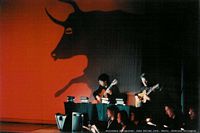 Musical
director and conductor, Bradley Bloom. Theatrical director,
choreographer, and stage director, the late Jim Posante. Live-performance
multimedia production about early human life situations,
religion, and cognitive development from the end of the Lower
Palaeolithic to the end of the Upper Palaeolithic. Schoolcraft College,
Livonia, MI. May 15, 16, & 17, 1996.
Musical
director and conductor, Bradley Bloom. Theatrical director,
choreographer, and stage director, the late Jim Posante. Live-performance
multimedia production about early human life situations,
religion, and cognitive development from the end of the Lower
Palaeolithic to the end of the Upper Palaeolithic. Schoolcraft College,
Livonia, MI. May 15, 16, & 17, 1996.
Sojournus Antiquitus involved over 50
faculty, staff, and students from most of the larger universities and
colleges in Southeast Michigan and neighboring Canada (institutions represented included Schoolcraft College; University of Michigan; Cranbrook Institute of
Science;
University of Windsor, Canada; Central Michigan University; Eastern
Michigan University; Wayne State University; and Greenhills School of
Ann Arbor).
- Positive Artists Coalition. 1985-1987. J. Feliks, Founder. A venue for artists, musicians, poets, and filmmakers to encourage
one another in their creative efforts. The Positive Artists Coalition culminated in a live-performance multimedia program called Nature's Final Cry, produced by the coalition members for
Wayne State University's Environmental Studies program (June 20, 1987). Nature's Final Cry was presented at the Belle Isle
Nature Center, and included original songs &
instrumentals, projected films, slides, and poetry, all created by the coalition's members.
The city of Detroit has had difficulty maintaining its unique cultural
heritage such as Belle Isle. Not only has it closed the Nature Center
on the island but it even closed the famous Belle Isle Aquarium
which was "the oldest continuously operating public aquarium in North
America." Belle Isle has been an inspirational part of my own life since early childhood. Here
is a link to the
Friends of Belle Isle Aquarium website and another to the Friends of Belle Isle website.
- Troika Image Arts, Inc. 1981-1982. Co-founder, composer, guitarist. Troika Image Arts (Hosain Mosavat, Pietro Di Giorgio, John Feliks) was a unique multimedia live performance trio
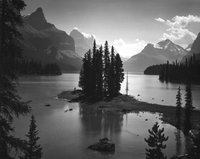 featuring original poetry and music synchronized and performed live to projected original b&w photography.
featuring original poetry and music synchronized and performed live to projected original b&w photography. 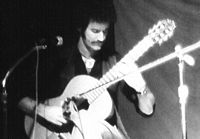 Troika Image Arts promoted public awareness of the grandeur and beauty of nature and its preservation. PHOTOS: 1.) The author in September 1981, photo by Ed Dumigan. 2.) Spirit Island,
Jasper, British Columbia, by Hosain Mosavat (student of Ansel Adams),
which is in the permanent collection of the Chicago Museum of Art. Troika Image Arts did performances around the Detroit/Ann Arbor area. [Coming later, mp3s of original poetry and music by Di Giorgio and Feliks.] A few highlight
performances:
Troika Image Arts promoted public awareness of the grandeur and beauty of nature and its preservation. PHOTOS: 1.) The author in September 1981, photo by Ed Dumigan. 2.) Spirit Island,
Jasper, British Columbia, by Hosain Mosavat (student of Ansel Adams),
which is in the permanent collection of the Chicago Museum of Art. Troika Image Arts did performances around the Detroit/Ann Arbor area. [Coming later, mp3s of original poetry and music by Di Giorgio and Feliks.] A few highlight
performances:
EXPERIMENTAL AND POETRY FILMS
- Kadjrel & Rahglen 1986, Registered ©1987. Experimental symbolic fantasy short spanning 583 million years beginning in the primordial Precambrian and Cambrian seas then jumping to the European
Neolithic
and Bronze ages, c. 6000 years ago.
Kadjrel & Rahglen featured a
broad
eclectic mix of paleontology, evolution; influences from Plato, Pythagoras, Hinduism,
Judaism,
Christianity, Buddhism, and Taoism; and the underpinnings behind these seemingly disparate elements - all in the medium of an epic transcendental love story.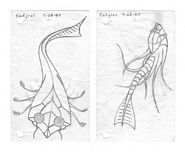
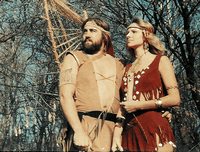 Included in the film is an "underwater" sequence filmed at the University of Michigan's Exhibit Museum of Natural History of it's Paleozoic seafloor dioramas. Kadjrel & Raghlen has been in the process of being reworked as a multimedia theatrical performance. SCAN: Later drawing board designs for Kadjrel and Rahglen as primordial sea creatures (1984). PHOTO: Actors in the original title roles (1984). Notice Kadjrel's armband and Rahglen's pendant.
Included in the film is an "underwater" sequence filmed at the University of Michigan's Exhibit Museum of Natural History of it's Paleozoic seafloor dioramas. Kadjrel & Raghlen has been in the process of being reworked as a multimedia theatrical performance. SCAN: Later drawing board designs for Kadjrel and Rahglen as primordial sea creatures (1984). PHOTO: Actors in the original title roles (1984). Notice Kadjrel's armband and Rahglen's pendant.
Responses to this film were across the
board, from near ecstatic to near rage. I made the mistake of submitting
this piece to a traditional film festival imagining that they would
appreciate its uniqueness, innovation and subtleties. This was surely a
mistake when it comes to encouraging experimental film. Some of the
judges' responses were, "The main theme of the film somewhat lost in
the special effects," "I did not get the message," and, "Your object
escapes me." But this is just the nature of experimental film. Kadjrel & Rahglen
was specifically written to be
transcendental and intuitive and not instantly grasped rationally.
This, of course, is contrary to how most
films are made and is equally contrary to the expectations of most
audiences. In fact, anticipating this problem, during production I was
also working on a study guide
called The Kadjrel & Rahglen Companion.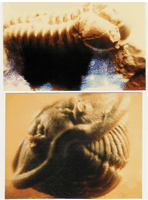
- Fossilosophy 1985. Short poetry film featuring intimate portraits of fossils on a backdrop
of original classical guitar music and philosophical musings. Images of the fossils, which were part of the author's collection of trilobites, brachiopods, and
bryozoans, were interspersed with closeup shots of the guitar part as performed and recorded for the film.
Fossilosophy, Kadjrel & Rahglen, and similar projects eventually led to the The
Impact of Fossils thesis paper and Sojournus Antiquitus
live-performance multimedia theatrical
production. PHOTOS: Actual stills from the film:
trilobites Calymene celebra (Silurian age, 420 million years old) from
Grafton, Illinois; and Flexicalymene meeki (Ordovician age, 450 million
years old), from Covington, Kentucky.
- Oasis 1984 (Finding peace of mind in a chaotic world).
 Short interlude film featuring the poetry of Pietro Di Giorgio and original guitar music of John Feliks. The film received a Bronze Medal in the 1984 Photographic
Society of America International Film Festival. PHOTO: Actual
still of the "Mirror Shot" sequence from Oasis featuring actor and
poet, Pietro Di Giorgio. Filmed, scored, and edited by John Feliks;
Impressionistic direction, John Feliks; Poetry by Pietro Di Giorgio;
Artistic consultant, Sharlet Di Giorgio.
Short interlude film featuring the poetry of Pietro Di Giorgio and original guitar music of John Feliks. The film received a Bronze Medal in the 1984 Photographic
Society of America International Film Festival. PHOTO: Actual
still of the "Mirror Shot" sequence from Oasis featuring actor and
poet, Pietro Di Giorgio. Filmed, scored, and edited by John Feliks;
Impressionistic direction, John Feliks; Poetry by Pietro Di Giorgio;
Artistic consultant, Sharlet Di Giorgio.
- Caress of Change 1983 (Musings on nature, urbanization, and how one's frame of mind changes with time). Short interlude film featuring the poetry of Pietro Di Giorgio and the original guitar music of John Feliks.

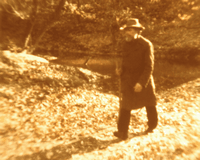
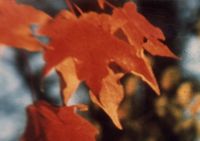 The film won 1st
Place and Best of
Show honors in the 1984 Michigan Council of Amateur Movie Clubs Film
Festival. PHOTOS: Actual
stills from the film. The middle picture is Di Giorgio, the only actor
in the film. Filmed, edited, and scored by John Feliks; Impressionistic
direction, John Feliks; Poetry by Pietro Di Giorgio; Artistic
consultant, Sharlet Di Giorgio. (Mp3 of Di Giorgio and Feliks poetry and guitar soundtrack
will be offered later.)
The film won 1st
Place and Best of
Show honors in the 1984 Michigan Council of Amateur Movie Clubs Film
Festival. PHOTOS: Actual
stills from the film. The middle picture is Di Giorgio, the only actor
in the film. Filmed, edited, and scored by John Feliks; Impressionistic
direction, John Feliks; Poetry by Pietro Di Giorgio; Artistic
consultant, Sharlet Di Giorgio. (Mp3 of Di Giorgio and Feliks poetry and guitar soundtrack
will be offered later.)
TRADITIONAL FILM WORK & VARIETY STAGE PROGRAMS
- 1984. Central theme song and two short instrumentals for award-winning 16mm film, Popcorn Man, by David Zaremba: 1985 Council of International
Non-Theatrical Events
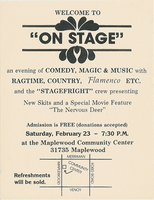 (Golden Eagle Award), 1986 Melbourne International Film
Festival (Gold Cineman), 1986 Hiroshima International Film Festival (Foreign
Minister's Prize). Edited by Grace Garland Janisz. (Mp3 of song, Men Dream, will be offered later.)
(Golden Eagle Award), 1986 Melbourne International Film
Festival (Gold Cineman), 1986 Hiroshima International Film Festival (Foreign
Minister's Prize). Edited by Grace Garland Janisz. (Mp3 of song, Men Dream, will be offered later.)
- 1980-1983. Various
comedy shorts such as Divorce Invitation, Ralph Austin: The $600 Man, and
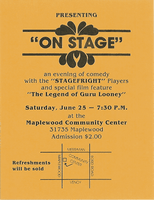 The Legend of Guru Looney, which I wrote, directed, filmed and edited (usually
within a couple of weeks or months turnaround) for a local
tri-yearly entertainment series called On Stage. The films were made specifically for the On Stage series for which my other responsibilities included being the series' founder, skit regular, and recruiter for the musical acts.
The Legend of Guru Looney, which I wrote, directed, filmed and edited (usually
within a couple of weeks or months turnaround) for a local
tri-yearly entertainment series called On Stage. The films were made specifically for the On Stage series for which my other responsibilities included being the series' founder, skit regular, and recruiter for the musical acts.
In addition to original films, On Stage featured
a wide variety of musical acts from rock and country to classical and
flamenco; multimedia programs such as the debut performance of Troika Image Arts (see above); and original live comedy skits written by the series' own comedy troupe. Among the now well-known musicians who appeared at On Stage were world-class classical guitarist, Scott Tennant, founding member of the Grammy-winning (2005) Los Angeles Guitar Quartet (the LAGQ was founded in 1980, the same year Mr. Tennant performed at On Stage); and multi-talented guitarist and percussionist, Mario Resto, who later did music for the Super Bowl and who currently records with brother and Oscar-winner, Luis Resto (2002, music for rapper Eminem's film, 8 Mile). While not quite
a Grammy or an Oscar, On Stage received
a "Certificate of Appreciation for Outstanding Service Rendered to the
City of Garden City," from the city's mayor.
RADIO WORK
- 1982. Co-producer, program director, fine arts host, and broadcast mix technician for Starting Point, a 13-week half-hour radio series featuring guest artists, musicians, and filmmakers. Sponsored by a grant from Kmart Corporation.
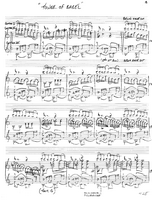 EARLY SONGS & INSTRUMENTALS
EARLY SONGS & INSTRUMENTALS
- 1969-2001. Here are a few samples of earlier material which may be offered for download at a later time. [The
author's musical work during the past several years is being
produced for the above-mentioned stage productions and is not included
in this sampling.] Clicking
on the links will eventually bring up
the info boxes for each of the songs or instrumentals which will also contain the mp3's. This is to make
sure that those interested in the music read a little background
information regarding each piece before listening to
them. SCAN: Page 8 from the original Tower of Babel handwritten score.
| 1. Discovery in the Minimal Zone |
(2:15) |
©2001 |
piano 4-hands |
instrumental |
| 2. The Cycles of Siluria |
(2:48) |
©2001 |
piano & synthesizer |
instrumental |
| 3. Autumn Exodus |
(3:20) |
©1992 |
piano |
instrumental |
| 4. Tower of Babel |
(4:12) |
©1991 |
3 classical guitars, 2 voices |
environmental song |
| 5. Marble Palace |
(4:17) |
©1989 |
classical guitar, bass, vocals |
love song |
| 6. Men Dream |
(2:06) |
©1984 |
guitar, synthesizers, voice |
life change song |
| 7. Spirit Island |
(2:13) |
©1981, 1982 |
classical guitar & poetry |
environmental theme |
| 8. Caress of Change |
(3:02) |
©1981, 1982 |
classical guitar & poetry |
environmental theme |
| 9. Dawn of Purity |
(1:48) |
©1981, 1982 |
steel-string guitar & poetry |
environmental theme |
| 10. I Know Ya From Someplace |
(3:17) |
©1979, 1982 |
classical guitar & 2 voices |
love song |
| 11. The Storm |
(4:07) |
©1978, 1980 |
live classical guitar & voice |
storm theme song |
| 12. Pretty Lente |
(2:53) |
©1969, 1973 |
steel-string guitar, 2 voices |
love song |
- 2002. Original pre-recorded music for live stage production, Lascaux: The Dawn of Art,
by director, Michael Lee (master-level student of renowned mime, Marcel
Marceau). Pieces included: "When the World Was New," "Thoughts in a
Painter's Mind," and "Dreaming Bulls of the Subterranean," all ©John Feliks 2002. Chelsea,
Michigan.
ARTISTIC ENVIRONMENTAL WORK
- 1989. Co-founder, Michigan Divers for the Preservation of Inland Waters. MDPIW,
which grew out of an informal snorkeling club, was created specifically to make a formal presentation to the Michigan Department
of Natural Resources (DNR) for the purpose of preventing a small public
lake
in a relatively secluded setting from being developed.
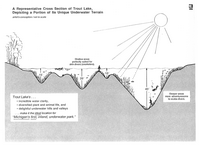
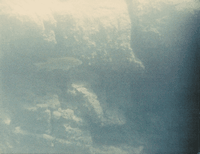
The group was concerned about having
safe lakes
(no fast boats or jet skis) with good underwater visibility within
short driving distance. An elaborate research and proposal package was
put together for the DNR presentation as well as a large 32" x 40"
photo-display panel and a 24" x 32" cross-section graphic of the lake. Our idea was, "Michigan's first inland underwater park." SCAN: A Representative
Cross Section of Trout Lake, Depicting a Portion of Its Unique
Underwater Terrain (concept, design
and layout, J. Feliks; final artistic rendition, S.
Errington). There were approximately 10 members in the group.
The presentation was successful and the construction project was
effectively postponed. PHOTO:
Fish picture similar to those used on the DNR presentation photo-display panel though taken at a different inland
diving location (photo using underwater camera, © J. Feliks
1989).
ABOUT THIS WEBPAGE
In lieu of my homepage and another primary page, which have been in process on-and-off for a
couple of years but not yet posted,
I have simply been adding interlinked pages in
whatever way they can somehow fit together, beginning with those
related to anthropology. Like the other pages in this interlinked series, this one is new and in the process of tweaking, so
please be patient as it goes through changes in content, wording and layout.
I am hoping to get
the main site up and running soon. It will offer many things that
are not science or even fine art-related such as mp3's
of original songs and instrumentals, lots of surprising and, hopefully,
entertaining things, as well as current projects and future plans.
E-mail: feliks (at) umich.edu
最近更新2009年12月6日。 © John Feliks 2009
 I can safely say that Warren Fahy’s debut science thriller, Fragment, offers a lot
of gold in
its undeniably dynamic mix. Make no mistake, Fragment is an
unpredictable and
wild ride for sure;
I can safely say that Warren Fahy’s debut science thriller, Fragment, offers a lot
of gold in
its undeniably dynamic mix. Make no mistake, Fragment is an
unpredictable and
wild ride for sure; yet, somehow, out
of all of this, comes not only many delightful moments
that will stick with you long after reading the book, but also one of
the most
elusive and subtle emotions one can experience...
yet, somehow, out
of all of this, comes not only many delightful moments
that will stick with you long after reading the book, but also one of
the most
elusive and subtle emotions one can experience...
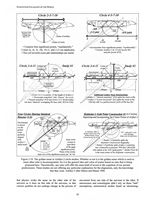






 featuring original poetry and music synchronized and performed live to projected original b&w photography.
featuring original poetry and music synchronized and performed live to projected original b&w photography. 











